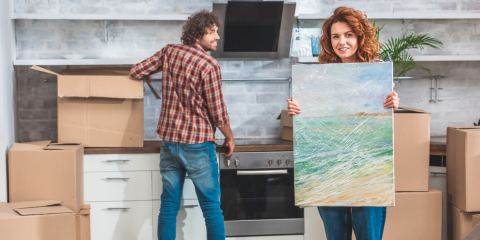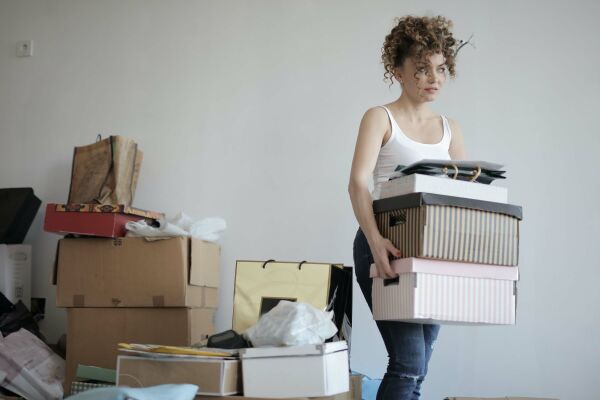Artwork is often a personal thing. Whether the artist is someone close to you, an unknown, or a prolific and well-known practitioner, we select and collect pieces that speak to us, that move us, or that reflect our style and complement our homes.
If you’re moving across town or across the country or are shipping a piece to a buyer, transporting your artwork so that it arrives undamaged and in one piece is of the utmost importance. The secret to safely moving art is to take the time to pack it using the right materials and a little extra care. Securely packing artwork for moving will often save you or your buyer heartache in the long-run, so hire a moving company that specializes in packing and shipping artwork or follow these steps:
1. Gather the right supplies
The type of packing supplies you need will vary based on the type of artwork you are moving:
Framed art |
Unframed prints |
Paintings or canvas prints |
Ceramics, pottery, or sculpture |
|---|---|---|---|
|
|
|
|
| PRO TIP: While packing peanuts may seem like an obvious choice, they actually don’t protect art as well as shredded or crumpled paper. In addition to being terrible for the environment, packing peanuts will settle to the bottom of the box, leaving the top of your artwork exposed and increasing the risk of damage. |
2. Pack and box it
With your supplies in hand, it’s time to set up your packing station and get your artwork ready to move.
| PRO TIP: If you are packing a piece of artwork you have created yourself, it is important that you make sure it is completely dry before packing it, otherwise it can easily get damaged. |
How to pack framed artwork
Place your framed artwork face down on a sheet of packing paper and wrap it like a gift, taking care to fold and tape the edges. For extra protection, after wrapping it in packing paper, wrap the frame in bubble wrap, with the bubble-side against the frame, and place cardboard corners on each corner of the frame.
| PRO TIP: Don’t let the bubble wrap touch the glass surface of the frame—it can leave difficult to clean marks. |
- Small- to medium-sized frames can be packed together in an appropriately sized box, with a sheet of cardboard placed between each frame.
- Large frames should be packed separately in their own specialty boxes, or crated for the most protection.
- If the frame is especially large, place the paper on the glass, followed by a layer of bubble wrap, and a sheet of cardboard on either side of the frame. Tape the cardboard sheets to each other and place cardboard corners on each corner of the frame.
Fill any empty space in the box with shredded or crumpled packing paper to prevent shifting.
How to pack paintings
For stretched canvases, follow these steps:
- Cover the front and sides with Glassine or another acid-free archival tissue paper, taking care to keep the tape away from the canvas itself.
- For additional protection, cut four squares of the paper and fold them in half twice diagonally to form triangles. Tape the free side of the triangles so they form corner pockets and affix them to the corners of the painting.

- To keep the artwork protected from cuts, indents, cracking, and stretching, cut two sheets of cardboard or foam-core to match the size of your painting and sandwich the wrapped painting between them.

- Wrap the painting in a plastic sheet or bag and tape it shut.
- Wrap the painting in bubble-wrap, with the bubble side facing inward toward the painting.
- Affix cardboard corners on all four corners of the painting.
- For smaller pieces, you can place multiple similar-sized works inside of an appropriately sized box.
For medium to large works, place the artwork inside a box of slightly larger than the piece.
For large to very large pieces 48 inches or longer on any side, place the artwork inside a crate. - To keep the artwork from shifting, fill any empty space in the box with packing material such as shredded or crumpled packing paper.
Watch this video for a step-by-step demonstration:
Packaging Wrapped Canvas Artworks (Under 48" x 48") from Saatchi Art on Vimeo.
How to pack unframed prints
You have two options for packing unframed prints:
- Stacked together vertically in the same appropriately-sized box, between two taped cardboard sheets.
- Wrapped around each other in a cardboard tube, with a sheet of archival-quality tissue paper in between each print.
How to pack sculptures, ceramics, or pottery
Stuff tissue paper into any open cavities in the piece. To protect the glaze or finish, wrap the piece in tissue paper before wrapping it in several layers of bubble wrap and securing it with tape.
Smaller pieces can be consolidated into one box, but large, heavy, or especially delicate pieces should be packed separately, or possibly even crated. Regardless of size, the box should be large enough to have at least two to three inches of cushion space on each side of the piece.
Fill the bottom of the box with shredded paper before placing the piece inside. To prevent shifting of the artwork, fill any empty space remaining in the box with more shredded paper. If placing more than one piece in a box, ensure that each piece is sufficiently cushioned
3. Add the finishing touches
Securely screw crates shut and seal all cardboard boxes carefully with strong packing tape, using the “H method”—taping along the seam where the box flaps join, as well as along both unfolded sides.
Label the artwork on both or all four sides of the box. Be sure to:
- Indicate that the contents are “FRAGILE”
- List the contents
- Label the destination room
For added safety, indicate which side should face up, and, if it’s a crated work, which side should be unscrewed. Include any additional instructions you think it may need.
4. Load it onto the truck
For frames and paintings, keep the box on its side. Boxes absorb shock more easily when resting on their edges, so secure them in place with straps and be sure to strategically place them away from heavy boxes that could crush or damage them.
Unframed prints and paintings can be stored wherever they fit, so long as they are not in a position to be crushed by other boxes.
For ceramics, pottery, or sculpture, how you load them will depend on the piece. For small- to medium-sized pieces, ensure that they are kept on top of all boxes to keep them from getting crushed. For larger sculptural pieces, load them upright to keep the pressure and weight where it belongs and secure it in place with straps, to keep it from crushing other items.
Conclusion
Whether you’re moving locally or long distance or are shipping a work of art to a buyer, carefully packing any artwork will ensure that it arrives at its intended destination in one piece. The way you pack it depends on the piece, but you should always:
- Select the right supplies for the type of work it is
- Take care to pack it securely to protect it from damage
- Label it to indicate the contents, instructions for how it should be treated, and where it should go
- Load it in a safe place on the truck
- Hire a professional moving company if you aren’t comfortable packing and shipping your artwork yourself
A secure packing job will get your works of art where they need to be safely, so they can provide you or its recipient with a beautiful piece of artwork and years of enjoyment.




